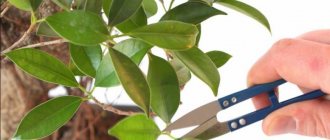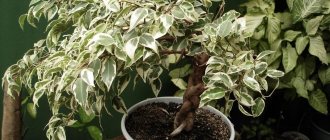- October 4, 2019
- Houseplants
- Olga Alekseeva
Ficus benjamina is distinguished by medium-sized foliage and a chic crown. It is popular among indoor plant lovers due to its unpretentiousness. The culture can be propagated by twigs or cuttings cut from the stem part. How to plant ficus benjamina at home is what often worries gardeners.
Propagation by cuttings
Spring (before early summer) is considered a suitable time for reproduction. This is a period of increased formation of roots and leaves. The shoots are cut off not only from the top of the plant, but also from the side branches. Ficus must be an adult. The stems and leaves are cut off from it.
How to plant ficus benjamina using cuttings? The cut branches are placed in a container of water and placed on a windowsill with good lighting. The water is periodically changed to clean. To avoid rotting, add aspirin or charcoal. Leaves should not fall into the water. In about a month and a half, the shoot will give roots.
Another way to plant a cutting is to place it not in water, but in wet sand. Cut a twig from an adult plant, wash it to remove the milky juice and dry it a little. Place in a container with wet sand. After the roots appear, the seedling can be placed in a pot of soil. Perlite is also used instead of sand.
How to plant Ficus Benjamin using a shoot without roots directly into a container? To do this, you must first process the cut on the cutting, and then create optimal conditions for the development of the plant: lighting, humidity and temperature.
Land requirements
For full growth, a fertile soil mixture is necessary; ideally, it should have the following properties:
- a suitable acidity level not exceeding pH = 6.5-7;
- breathability;
- content of vitamins and micronutrients.
Important! The concentration of nutrients in the soil must correspond to the norm, since an excess of potassium, nitrogen and phosphorus leads to a weakening of the plant’s immunity, as well as deformation of its shoots and leaf blades.
Stagnation of moisture in the soil is detrimental to indoor ficuses ; this can be avoided using a drainage system. A high drainage layer will ensure good circulation of air and water near the root system.
The composition of the soil directly depends on the age of the plants for which it is intended.
Young specimens need a loose mixture containing the following components:
- humus;
- turf land;
- peat;
- sand.
Turf should be taken from areas where perennial grasses grow; its combination with humus allows you to obtain a nutritional composition. Peat and sand will promote the passage of water and air. You can also use the following as leavening agents :
- charcoal;
- coarse sand;
- or expanded clay.
Their presence in the soil will prevent stagnation of moisture, leading to rotting of the root system.
Adult ficuses require denser soil with the following composition:
- sand;
- humus;
- leaf soil.
Important! To grow ficus plants, it is unacceptable to use soil with a clay structure.
If the acidity level is below pH 6.5-7, lime or dolomite flour should be added to the soil, and if it increases, peat should be added.
Which pot should I plant Ficus Benjamin in?
A container of the correct shape with the same width and height will suit the plant, but if you want original options, you need to take into account the recommendations:
- You should not take a round pot. When transplanting a plant into such a pot, the roots may be injured. This will lead to crop diseases.
- In an elongated pot, the amount of soil will exceed the required norm, which will lead to slower growth. The flower will direct its forces to build up the root system, and only after that will it grow in height. But you can cheat and buy an elongated pot with a false bottom.
- How to plant a ficus benjamina branch if you plan to form a bonsai? In this case, it is better to take a flat container that resembles a bowl.
Features for different types
Despite the fact that the basic composition of the soil for different varieties of ficus is identical, there are some nuances when growing each species.
Ficus benjamina
The most famous and widespread variety is Ficus Benjamin. This plant grows well in soil that has a loose structure, allows moisture to pass through well and is rich in nutrients. Ficus Benjamin does not tolerate soil that is too wet and flooded with water - it quickly dies in it.
You should not plant ficus benjamina in soil that has a high level of acidity. For such a plant, the most suitable soil is neutral or low pH (6.5-7 units). When buying a substrate in a store, it is best to ask the seller for a recommendation - he will tell you exactly what soil to choose, how to supplement it, and how to grow the plant correctly in general.
Ficus elastica
The second most popular type is the so-called “elastic”, or rubbery, or elastic ficus. This beauty's main soil preferences are porosity and nutritional value. If the soil for the rubber-bearing ficus was purchased in a store, it must be supplemented with sand, turf soil or humus resulting from the decay of foliage.
A young “elastic” ficus needs to be replanted annually, and into a pot with a larger diameter. After such changes, the plant literally comes to life - it begins to grow even faster and becomes stronger. The preferred replanting option is transshipment, when the plant is carefully removed from the pot, dumping it out and leaving a little old soil on the roots.
If the ficus begins to actively shed leaves, it means that the soil is too wet - you need to temporarily stop watering, and then set the optimal mode: water when the soil dries out 1-2 fingers. From April to September, the plant actively consumes nutrients; at this time, it is advisable to feed the “pet” with organic fertilizers containing nitrogen and liquid mineral compounds alternately.
In spring and summer, it is advisable to transplant the young “elastic” ficus into a larger pot and change the soil. Adult plants can be replanted once every 2-3 years. You can tell that the soil in the pot is very depleted by the liquid quickly flowing into the pan when watering the ficus.
Advice: if the plant is too large, there is no need to replant it into a new pot - just regularly remove the top layer of soil and add a new, more fertile and nutritious one.
Ficus Microcarpa
The original appearance of the ficus Microcarpa with roots sticking out and often having a bizarre shape is a striking feature of the plant. In terms of care, this ficus is no more demanding than other varieties: it does not tolerate strong moisture, needs regular soil changes, and is demanding of fertile soil.
Often, due to its unique shape, Ficus Microcarpa is grown in bonsai style. In this case, the plant needs specialized fertilizers. It is recommended to add them to moist soil - this way the nutrients are better absorbed. The number of transplants of such a ficus is once every 2 years. Due to the almost non-growing trunk, there is no need to buy large pots for the plant; the main purpose of replanting is to completely or partially change the soil. Like other varieties, Ficus Microcarpa prefers drainage soil.
Flowerpot material
Not every container is safe for humans and plants. Manufacturers often use toxic materials that reduce the cost of flowerpots. For example, low-quality plastic, in contact with soil, water, and fertilizers, releases harmful substances. As a result, the flower will get sick or even die.
Therefore, you should prefer natural materials:
- wood - usually used for large containers;
- glass - ideal for ficus;
- clay - bowls made from it are used for bonsai;
- ceramics - such pots are durable and beautiful.
Container size
How to plant ficus benjamina correctly? It is important to take into account the parameters of the ficus.
When choosing a pot, consider some points:
- The “two centimeters” rule. The size of the pot should be such that the roots do not reach the walls by a couple of centimeters.
- You should not immediately place a miniature sprout in a container that is too large. In this case, the flower will devote all its energy to the development of roots.
- A very small container is also undesirable; the plant will not be able to develop.
- A container made of soft material is convenient, since it is then easier to remove the ficus from it along with a lump of earth without damaging the roots.
What soil does the plant need?
As a rule, for ficuses a mixture is chosen: “Ficus” or “Palm”. Almost every manufacturer produces similar products. The most famous of them include:
- Seramis;
- Garden of Wonders;
- Flower happiness;
- Vermion;
- Veltorf;
- Seliger-Agro.
As a rule, the compositions differ from each other, but they mainly contain the following components:
- vermicompost;
- mineral supplements;
- sand;
- dolomite flour;
- peat;
- lime;
- expanded clay
Store-bought soil is ready for use and does not require additional processing.
Ficus benjamina requires neutral or slightly acidic soil that drains moisture well and is enriched with nutrients.
The flower reacts painfully to even slight stagnation of moisture in the pot . If the soil brought from the store is too dense, it is recommended to add a small amount of sand, this is especially true for young specimens.
How to plant ficus benjamina with a shoot?
Drainage and special soil for ficuses are poured into the bottom of the container: it has a loose structure. Then the cutting is planted. How to properly plant ficus benjamina in a pot? It is useful to create a greenhouse effect by covering the plant with a jar or bag. This will ensure that the correct temperature and humidity levels are maintained.
Rooting occurs within 20 days. After this, the plant stretches upward. However, you should not immediately remove the greenhouse. This can be done after at least one leaf appears. The greenhouse is periodically removed from the ficus, giving the plant the opportunity to get used to the conditions of the room. Then the greenhouse is removed completely.
How to make a substrate with your own hands?
You can prepare the soil mixture for ficus yourself and thereby control its composition, as well as enrich it with the components necessary for a particular phase of development of specific specimens.
The disadvantage of this solution is the labor-intensive process and the inability to find some components on sale.
Self-prepared soil must be disinfected by watering it with a solution of potassium permanganate, or by calcining it in an oven at a temperature of +100 °C.
The composition of the soil is determined by the type and age of indoor ficus.
So, for example, to obtain a mixture for rubber-bearing microcarp you will need :
- Combine turf and leaf soil in equal parts.
- Add ½ of the total amount of river sand.
- The bottom of the container should be lined with a layer of drainage, for which it is acceptable to use small pebbles or broken bricks.
- Pour a layer of sand on top.
Land for Ficus Benjamin:
- combine peat, humus and leaf soil in a ratio of 1:1:1;
- add small pebbles and river sand, then mix everything thoroughly;
- Line the bottom of the pot with layers of expanded clay and sand.
For petiolate ficus and Palmera:
- mix together: turf, leaf soil, sand and impurities in a ratio of 1:2:2:1;
- add brick chips, pebbles and gravel;
- Place charcoal and expanded clay on the bottom.
Important! Charcoal not only makes the soil light, but also protects the plant from pathogenic bacteria.
Need for transplant
After some time, the plant will need updating. It is moved to a new container. In this case, a number of actions are performed:
- The soil is moistened.
- Carefully remove the ficus from the pot.
- Cut off the roots by about a third of their length.
- Place the plant in a new pot.
- After the procedure, the flower is lightly watered and placed in a place hidden from sunlight. While undergoing adaptation, the ficus sheds its leaves. This is completely normal and should not bother the owner. As you get used to the new pot, foliage will appear on the plant again.
Features of growing and caring for ficus
Ficus is a native of the tropics. The plant needs warmth, good lighting, high humidity and fresh air.
Recommended conditions for its cultivation and care measures are collected in the table:
| Lighting | Good, diffused, needs lighting in winter |
| Location | Western, eastern window sill. Doesn't tolerate change of location well |
| Air temperature | In summer +25…+30°С, in winter +16…+20°С |
| Air humidity | 50–70% |
| Ventilation | Regular access to fresh air and protection from drafts is required |
| Watering | Moderate in summer (2–3 times a week), scanty in winter (1 time a week), warm, settled, filtered rainwater, as the top soil layer dries |
| Spraying | In summer, regular use of warm, settled or boiled water |
| Top dressing | In spring and summer, 2 times a month with nitrogen-containing fertilizers (nettle, mullein, wood ash infusion, “Ideal”, “Gumisol”, “Ficus”, “Palma” fertilizers); not required in autumn-winter |
| Transfer | If necessary, by transshipment method, annually - renewal of the top soil layer |
| Trimming | Sanitary and formative, from the beginning of spring to the first ten days of summer |
How to “intertwine” stems
How to plant ficus benjamina so that the stems intertwine? This question is usually asked by experienced flower growers who want to add sophistication to the interior. You can achieve such an interesting effect in different ways. There are several types of weaving:
- "lattice";
- "braid";
- "spiral" or "hedge".
Landing rules:
- The implementation of the idea begins at the stage of growing a young seedling. You will need several shoots (3-5 pieces), which are placed in one container next to each other. The height of each plant should be 15-17 cm.
- Preference is given to ficus trees whose trunks are no more than half woody. Otherwise it will be difficult to braid and the stems will break.
- If there are only two copies of a flower, then a “spiral” can be made from them.
- The trunks are braided when the ficus reaches a minimum height of 13 cm. As it grows, the grower twists the branches in the intended direction.
- A tall and voluminous plant needs support during weaving so that the tree does not fall. Then the support is removed.
How to properly prepare the ground?
In addition to properly selected components, it is necessary to prepare the soil in one of the following ways:
- Mechanical – removal of all foreign impurities.
- Thermal – exposure to high temperature or freezing.
- For steaming, use a microwave or oven, as well as a water bath, followed by drying.
- When freezing the soil is placed in low temperature conditions for a long time, it should be noted that this method does not help get rid of harmful microorganisms and weeds.
- Chemical – treatment with pesticides, potassium permanganate solution or biological products.
How to braid a pigtail
This method is not as simple as it might seem at first glance, but it is not impossible. How to plant ficus benjamina to create such an interesting composition in the future?
Weaving rules:
- Select several shoots and plant them in one container next to each other. This will allow you to intertwine them neatly, and the final result will be aesthetically pleasing.
- When side branches appear, they are cut off, leaving only the tops.
- Before the actual weaving process, the flower is generously watered. The stems will be flexible and easier to manipulate.
- The weaving procedure takes several months. This is explained by the slow growth rate of the trunk. First, make several turns and tie the braided stems so that they do not come apart. You can leave gaps between the branches or place them tightly. It depends on personal preference. Some gardeners weave in a third stem, making it stand out from the others - there is no limit to imagination.
Signs of incorrectly selected land
With improper care or an unsuitable microclimate, the plant will experience changes in appearance.
If the soil is not suitable for him, then this can be recognized by the following signs:
- change in leaf color;
- falling leaves;
- infection by fungus gnats.
If such problems arise, the flower must be transplanted into new soil made up of the right ingredients.
Fungus gnats are destroyed by insecticides: “Decis”, “Aktellik”, “Agravertin”, “Aktara”, “Intavir”. Did you know? The oldest ficus grows in Buenos Aires. It was planted in 1781. It was given the name Homer's Tree.
If you are one of those who likes to keep indoor plants and decide to plant a ficus, you need to provide it with the kind of soil that nature intended for it. Ficus will not require much attention. Even those who grow a flower for the first time can handle its planting and care.
Lattice weave
This is a more complex type of weaving, but the resulting beauty will not leave anyone indifferent. How to plant a ficus benjamina cutting to end up with a “trellis”? The classic weaving method involves the presence of eight plants. But they will require a large pot and a lot of free space. You can take a smaller amount, but it must be even.
Stages of forming the “lattice”:
- Young plants are planted in a pot in one line, measuring an equal distance from one to the other. If this condition is violated, the aesthetics of the composition will disappear.
- When the trunks grow to 10-12 cm, they are intertwined with each other using cardboard tubes in the center.
- After some time, the bushes are directed in the right direction. The lattice may not be straight, but have an original bend. The manifestation of imagination is only welcome.
- You can use wire with a winding, it can be easily removed.
There is another way to create a “lattice”. It is distinguished by simplicity and originality at the same time. To create a trellis, take the trunk of a coconut and plant it in the center of the pot. Due to the increased humidity of the trunk, the ficus will form aerial roots intertwining with each other.
Young sprouts are planted at a considerable distance from the coconut. Side shoots are pruned. The layers will gradually intertwine, resulting in an original composition. This method of creating a “lattice” is the least traumatic for the flower.
"Spiral" or "hedge"
This is a circular ficus weave and looks very attractive. It is easier to form such a composition than a “pigtail” or “lattice”.
To create a “spiral” follow these steps:
- A strong support is placed next to the cuttings.
- As the trunk grows, it is wound onto a support. The side branches are pruned.
- When the bush has stopped growing, the support is removed. If the trunks are intertwined, the composition is ready.
To create a hedge, follow these steps:
- Young ficuses are planted in a row at the same distance between plants.
- As the flowers grow older, they are intertwined with each other in random order.
Crown formation
Not all gardeners strive to form an original weaving of ficus trunks, but most of them are worried about creating a beautiful crown. Preventive pruning of the plant is carried out regularly. It involves removing dried ficus branches, since such shoots can spread the infection.
Anti-aging pruning is performed to ensure that the flower grows quickly. By pruning you can get rid of the defect of lack of branches. The wire will help direct the plant's growth in the desired direction. If it is necessary to form a crown in the shape of a bush, the shoots are pinched. This procedure activates the lateral buds, which allows you to grow and form a dense crown.
Ficus bonsai
This is exactly the variety that will make a wonderful bonsai. Beginners should prefer the classic form - Tekkan. It is characterized by a straight trunk, branched roots and the absence of branches in the lower part of the trunk.
To give the desired shape to the roots, they are trimmed several times. The same is done with the trunk. The manipulation is repeated until the trunk takes the desired shape. Then they begin to form the crown. Branches are cut to 2-4 leaves. In the cold season, the procedure is stopped.
Care measures
Knowledge of how to plant ficus benjamina at home is not enough to grow a gorgeous flower. It is important to properly care for plantings, creating the conditions necessary for development:
- Lighting. Ficus “loves” places with indirect light. You can place it at a distance of 1 meter from the south window. In winter, the flower is provided with additional lighting, since if there is not enough light, the plant sheds its leaves.
- Temperature. In the summer season, its parameters should be from 18 to 23 °C.
- Air humidity. It needs to be increased by spraying the plant with warm water. Ficus should be placed away from heating radiators.
- Watering. Its frequency may vary depending on the time of year. The soil is not waterlogged. Watering is carried out in several stages until the entire earthen ball is saturated. Excess water is drained from the pan.
- Priming. Slightly acidic fertile soil is suitable for ficus. When preparing it yourself, take part of the turf and part of the sand and add a little coal. Drainage must be poured down.
How to plant Ficus Benjamin correctly has now become clear. If you follow these rules, the gardener will be able to grow a beautiful green bush. Ficus will become an original detail of any interior, decorating the space.
How to plant a plant in the soil?
The optimal time to transplant a ficus is spring, since the plant has time to adapt before the onset of cold weather. In autumn and winter, such a procedure is permissible only in emergency cases, when:
- specimen diseases;
- damage to the pot;
- proliferation of pests in the soil;
- or the appearance of an unpleasant odor.
Transplanting a ficus into the soil will involve several steps:
- Selecting a suitable container (to make the flower stable, it should be as heavy as possible).
- Lay out the bottom of the pot with a layer of drainage with a height of at least 2 cm, then pour in the soil mixture:
- for an adult plant - ½ capacity;
- for a young person - almost to the top.
- Form a depression in the soil, place the flower in it and cover with the remaining soil.
- Water thoroughly and drain the remaining moisture from the pan after 15-20 minutes.
Attention! Adult specimens are most often transplanted by transshipment together with an earthen clod.
The root collar should not be allowed to go deep , otherwise the ficus will begin to rot.
Ficuses are relatively unpretentious plants that can fit into any interior. Transplanting and caring for them is not accompanied by any difficulties and can be done even by inexperienced flower growers.











